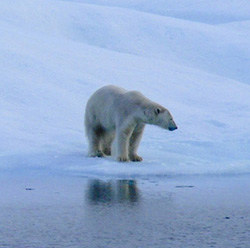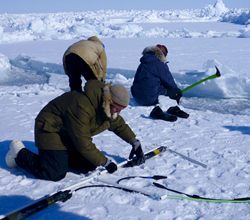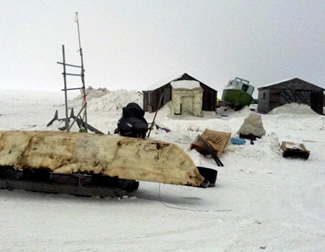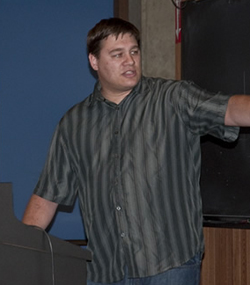The Call of the Arctic
Scripps scientists deploy new technology to track changes facing inhabitants of the north
Mario Aguilera | March 14, 2011

A 2009 photo taken during a joint expedition with the United States Coast Guard polar icebreaker Healy and the Canadian Coast Guard's Louis S. St. Laurent in the Arctic Ocean's Beaufort Sea. Photo: Patrick Kelley, U.S. Coast Guard photos
For thousands of years, the native peoples living along the world’s northernmost seas have forged an intimate relationship with their environment. The indigenous inhabitants of the Arctic Ocean’s Chukchi and Beaufort seas view themselves as tied to the sea, ice, and other elements of the natural world—even spiritually connected to the animals they hunt and regard as offerings toward the continued subsistence of their people and way of life.
From generation to generation, the Inupiaq people inhabiting regions along Alaska’s North Slope have passed down traditional knowledge about the often harsh and unforgiving environment of the extreme north.
But now their world is changing.
A warming climate is melting ice cover in the Arctic. The National Snow and Ice Data Center recently reported that January 2011’s Arctic sea ice extent was the lowest for any January since satellite records began in 1979. Inupiaq village elders remember a time in their youth when the ice kept firm on the coastline year-round. Today, the Inupiaq see such “land-fast ice” only in winter and spring, with the ice edge retreating northward hundreds of miles in summer. Industrial activities are also encroaching on the Inupiaq’s way of life. The allure of Arctic oil and gas exploration and new shipping lanes rises as sea ice recedes and opens more navigable waters.
In 2006 researchers at Scripps Institution of Oceanography at UC San Diego deployed a novel acoustic technology to monitor underwater sound and marine mammal calls in the high Arctic. The project flourished through collaborations with wildlife scientists and the Inupiaq. It also opened the door to an education and outreach program that gives native Alaskan students opportunities to tackle cutting-edge science while fostering new understandings of the Arctic and its wildlife in the face of global change.

Polar bears and other Arctic dwellers face uncertain futures as a warming climate melts ice cover. Photo: Steve Roberts, NCAR/EOL
The Northern Frontier of Acoustics
Many unknowns remain about the biology and ecology of the Arctic’s marine mammal inhabitants. Impediments to gaining this knowledge through traditional scientific methods include the frigid and windswept conditions of the Arctic, compounded by winters shrouded in darkness.
John Hildebrand and members of his Whale Acoustics Laboratory at Scripps confronted these obstacles from a new direction. A few years prior, Hildebrand and Scripps principal development engineer Sean Wiggins created a new technology for listening to the information-rich sounds emitted by marine mammals. Their U.S. Navy-funded High-frequency Acoustic Recording Package, or HARP, sits on the ocean floor with a hydrophone, or underwater microphone, coupled with a bank of memory storage disks. It continuously records the kaleidoscope of calls, clicks, whistles, moans, and songs from marine animals over the course of several months.
Beginning in the early 2000s, Hildebrand and Wiggins proved the technology's value to understanding marine mammal population numbers and habitats through deployments off Southern California, the Gulf of California, and other locations.
But the Arctic presented a new challenge on several fronts.
“We got interested in the Arctic because of the issues of global warming and the fact that marine mammals are very dependent on the ice, which sets the tone for the whole ecosystem,” said Hildebrand. “There is evidence now that killer whales are moving into the Arctic, an area they had never been before. We also worry about ice seals and walruses and what happens to them as the ice retreats.”
When HARPs first entered Arctic waters five years ago, Hildebrand and his team engineered the instruments to capture a year's worth of acoustic information per deployment under the rigors of frigid temperatures and several months of concealment underneath a thick layer of ice.

Scripps Development Engineer Ethan Roth (foreground) works to set up a hydrophone array in the Arctic in April, 2010. Acoustic data provide a long-term baseline for underwater ambient noise. Photo: Lindsay Kendall.
"This data is a snapshot in time, an environmental record," said Hildebrand. "It's a way of seeing what the Arctic is like at this point in time because things are changing. Fifty years from now, people can go back to our sound recordings and say, 'That's the way the Arctic was in 2006,' and compare it to the way things change in the next few decades."
The Arctic Changes
In late March 2011, as he has for the past five years, Scripps development engineer Ethan Roth will trek back to the Arctic Ocean frontier along with Josh Jones, a staff research associate in Hildebrand's group.
They will retrieve data waiting inside three HARPs sitting on the Arctic sea bottom that were deployed farther north than similar monitoring instruments. The data have proven beneficial to scientists who track the abundance and distribution of bowhead whales, animals with spiritual bonds to the Inupiaq people. Accurate assessments of the bowhead population and migratory routes are important for the conservation of the species, but much remains to be learned about their movements across large areas of the Alaskan Beaufort and Chukchi Seas during different times of year. Population estimates of bowheads have relied on observations made from land-fast sea ice during the spring, as well as from aerial surveys during the fall.
"People can go out five miles on the ice and look for animals, but they can't go out 100 miles and look for them-that's what the HARPs can do for us," said Roth. "We are providing evidence as to where some of these animals actually are throughout the year, which has not been understood well because people can't go out in winter and look for them. So we're helping to fill in the whole picture."
HARP data are providing the Arctic inhabitants other insights. The majority of the Bering-Chukchi-Beaufort bowheads, estimated to number between 12,000-13,000 individuals, were traditionally thought to travel near the coast along a migration corridor. But HARPs are revealing that they also use offshore areas to the north during migratory periods and other times of year. If this is a new trend, it may have been induced by increased openings in the thinning ice cover.

Browerville, Alaska, a community of Barrow, on April 19, 2010.
The data also provide a long-term baseline for underwater ambient noise, which will be important as the ice pack changes and noise from seismic exploration and other human activities increases and potentially impacts marine animals.
Roth and Jones have been able to gain a special perspective through partnerships with scientists working in the region, including the Alaska Department of Fish and Game and North Slope Borough.
"The people of the Arctic manage their resources very responsibly," said Roth, who is studying changes in the Arctic while admitting that working in that environment is changing him as a person, funneling his passion for science into a friendship and devotion to the well-being of the North Slope communities. "It's in their interest for the whale population to fully recover from the days of commercial whaling so they can continue to keep living the way they have for thousands of years and that has really added a human element to this project."
The project, science, and experiences with the people of the Arctic have left indelible impressions on Roth.
"Going up there and being in (the Arctic)," Roth said, "there is almost no way it can't change you."
A New Generation of Knowledge
While he has traveled the world's oceans as a captain of a research vessel and spent countless hours in the presence of marine mammals, Jones is uncovering plenty of new experiences in the Arctic Ocean.
Through the HARP data, Jones has experienced a new window on the Arctic, such as the amazingly long sounds emitted by a bearded seal in search of a mate (individual calls can be over a minute long), the territorial barks of a ringed seal defending its ice hole, or the complexity of seven different calls made by ribbon seals.

Arctic ribbon seal. Photo: Michael Cameron, NOAA-NMFS
"We know a lot about what these animals do near shore, but very little about how they use the offshore environment, especially during the winter when few studies have been done," said Jones. "Whether it's mating, feeding, or migrating, we are working on creating an acoustic guide to these species and their sounds. We're also building a picture of when they use the habitat in our study area and how that relates to the presence or absence of sea ice."
Jones is contributing to the scientific goals of the Arctic project, but he also has been instrumental in building a companion education and outreach program. Six years ago he started an initiative called SeaTech in which Southern California students were brought together with marine scientists to cultivate an appreciation of oceanography through field excursions and immersive activities.
The program flourished and Jones, working alongside Hildebrand and Roth, decided that the great northern frontier would be ideal for a new chapter of SeaTech.
They began working with Mt. Edgecumbe High School in Sitka, Alaska, a boarding school where 85 percent of the students are Alaskan natives.
Michael Mahoney, a Mt. Edgecumbe science teacher, immediately embraced the SeaTech concept. Through the program, Mahoney's students pore through HARP data to detect and analyze marine mammal sounds, advancing the Scripps scientists' efforts to understand the changing environment of the north.
"The prospect of doing actual science was the real draw," said Mahoney. "The students were extremely interested in this new opportunity to work with some of the world's best scientists and do real research, as opposed to just learning facts out of a textbook—it's so much more rewarding to become a valuable member of a team."

Mt. Edgecumbe High science teacher Michael Mahoney.
Ian "Chachi" Sia, a 2010 graduate of Mt. Edgecumbe, was so inspired by his two-year SeaTech experience that he chose to attend UC San Diego, where he works in the Hildebrand lab in addition to his freshman coursework.
Sia says he was drawn to the program with the idea of conducting real science in high school combined with exposure to the amazingly varied sounds the animals produce.
"The thing that really motivated me is that I got to go out on a boat with the scientists and see all of the hardware and engineering," said Sia. "It was a really cool experience and it opened my eyes to the whole research side of the job market. It made me want to make a difference in the world."
And so Hildebrand, Roth, and Jones hope that HARP data can broaden the knowledge base of the Arctic soundscape and the information can be passed on to new generations of the north.
This story originally appeared in Explorations, the magazine of UCSD's Scripps Institution of Oceanography.

|